Challenges and Solutions: Health and Safety in UK Construction
VerifiedAdded on 2020/05/04
|83
|19576
|91
Report
AI Summary
This report investigates the factors that encourage health and safety participation within the UK construction industry, addressing the challenges and solutions in the UK. The research utilizes quantitative data analysis from a survey of construction companies and qualitative analysis through interviews with operation managers. Key findings highlight the importance of a strong safety culture and worker participation in safety activities. The study identifies challenges such as worker attitudes, lack of understanding of risks, and organizational resistance to change. The report examines the health and safety regulations in the UK, the factors contributing to accidents, and the role of worker participation. The findings suggest that staff's lack of understanding of workplace risks is a significant barrier to implementing effective health and safety practices. The report also discusses the initiatives taken by senior management, skills to improve health and safety attitudes among the workforce, and the perception of workers taking health and safety seriously. The study concludes with recommendations for improving health and safety practices in the construction industry, focusing on the need for continuous improvement and a proactive approach to hazard identification and mitigation.
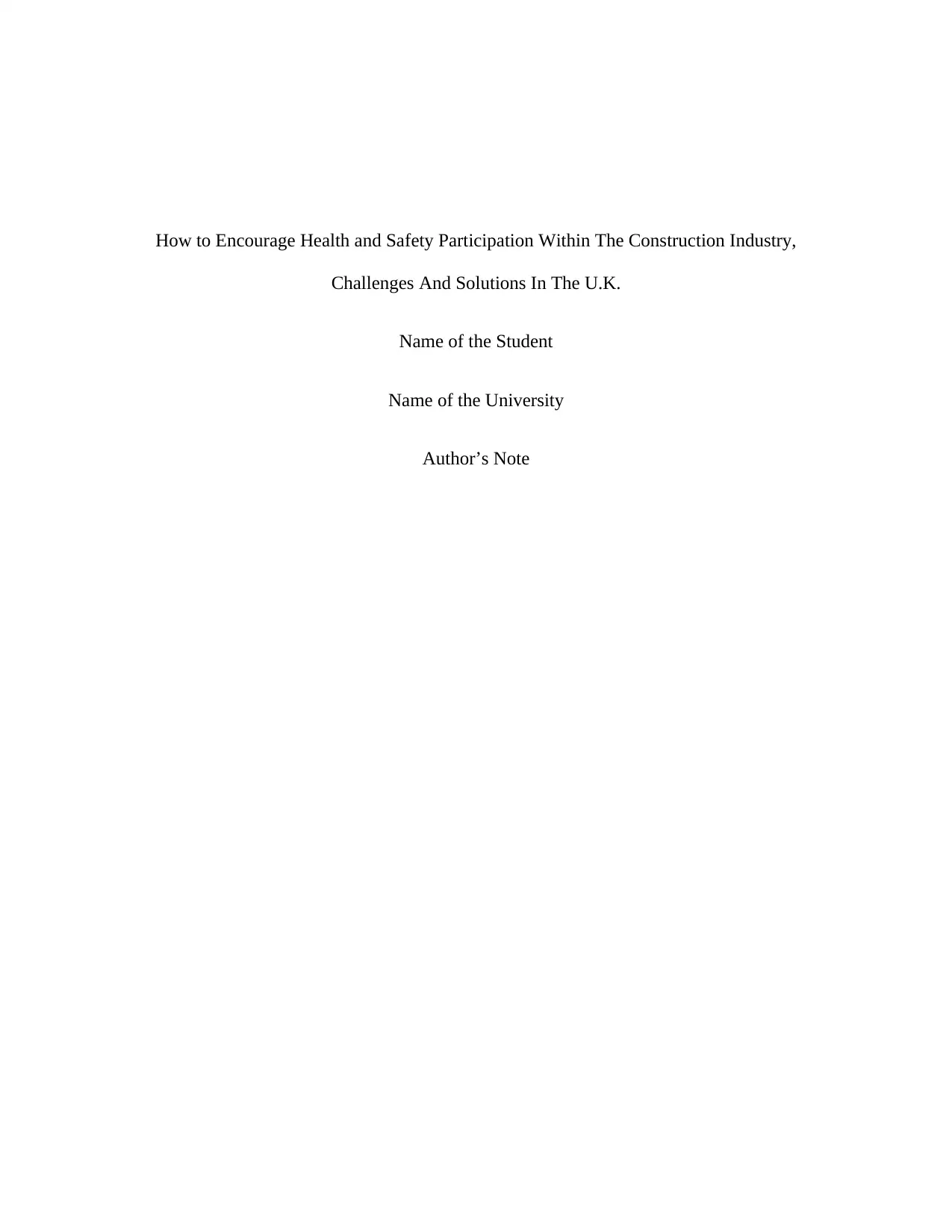
How to Encourage Health and Safety Participation Within The Construction Industry,
Challenges And Solutions In The U.K.
Name of the Student
Name of the University
Author’s Note
Challenges And Solutions In The U.K.
Name of the Student
Name of the University
Author’s Note
Paraphrase This Document
Need a fresh take? Get an instant paraphrase of this document with our AI Paraphraser
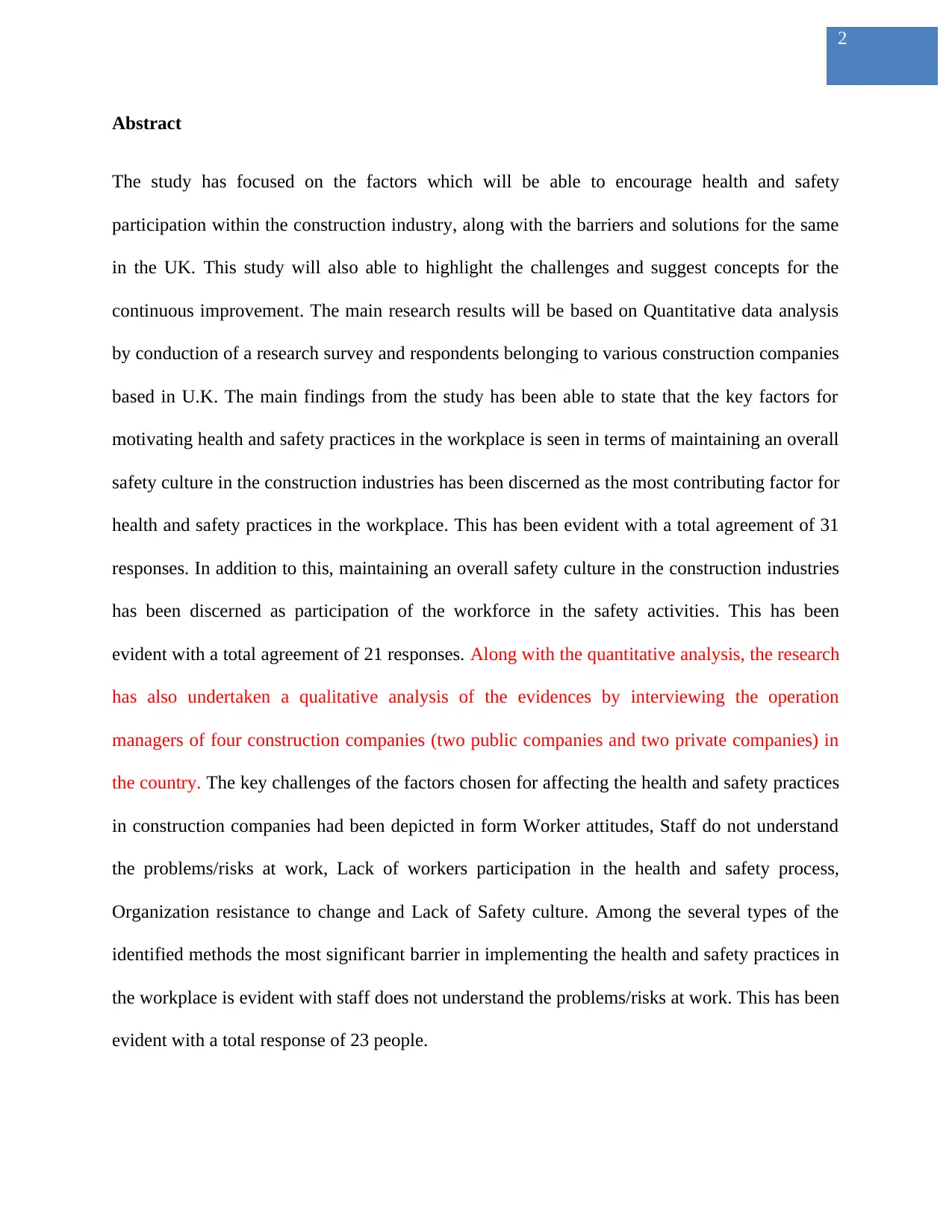
2
Abstract
The study has focused on the factors which will be able to encourage health and safety
participation within the construction industry, along with the barriers and solutions for the same
in the UK. This study will also able to highlight the challenges and suggest concepts for the
continuous improvement. The main research results will be based on Quantitative data analysis
by conduction of a research survey and respondents belonging to various construction companies
based in U.K. The main findings from the study has been able to state that the key factors for
motivating health and safety practices in the workplace is seen in terms of maintaining an overall
safety culture in the construction industries has been discerned as the most contributing factor for
health and safety practices in the workplace. This has been evident with a total agreement of 31
responses. In addition to this, maintaining an overall safety culture in the construction industries
has been discerned as participation of the workforce in the safety activities. This has been
evident with a total agreement of 21 responses. Along with the quantitative analysis, the research
has also undertaken a qualitative analysis of the evidences by interviewing the operation
managers of four construction companies (two public companies and two private companies) in
the country. The key challenges of the factors chosen for affecting the health and safety practices
in construction companies had been depicted in form Worker attitudes, Staff do not understand
the problems/risks at work, Lack of workers participation in the health and safety process,
Organization resistance to change and Lack of Safety culture. Among the several types of the
identified methods the most significant barrier in implementing the health and safety practices in
the workplace is evident with staff does not understand the problems/risks at work. This has been
evident with a total response of 23 people.
Abstract
The study has focused on the factors which will be able to encourage health and safety
participation within the construction industry, along with the barriers and solutions for the same
in the UK. This study will also able to highlight the challenges and suggest concepts for the
continuous improvement. The main research results will be based on Quantitative data analysis
by conduction of a research survey and respondents belonging to various construction companies
based in U.K. The main findings from the study has been able to state that the key factors for
motivating health and safety practices in the workplace is seen in terms of maintaining an overall
safety culture in the construction industries has been discerned as the most contributing factor for
health and safety practices in the workplace. This has been evident with a total agreement of 31
responses. In addition to this, maintaining an overall safety culture in the construction industries
has been discerned as participation of the workforce in the safety activities. This has been
evident with a total agreement of 21 responses. Along with the quantitative analysis, the research
has also undertaken a qualitative analysis of the evidences by interviewing the operation
managers of four construction companies (two public companies and two private companies) in
the country. The key challenges of the factors chosen for affecting the health and safety practices
in construction companies had been depicted in form Worker attitudes, Staff do not understand
the problems/risks at work, Lack of workers participation in the health and safety process,
Organization resistance to change and Lack of Safety culture. Among the several types of the
identified methods the most significant barrier in implementing the health and safety practices in
the workplace is evident with staff does not understand the problems/risks at work. This has been
evident with a total response of 23 people.
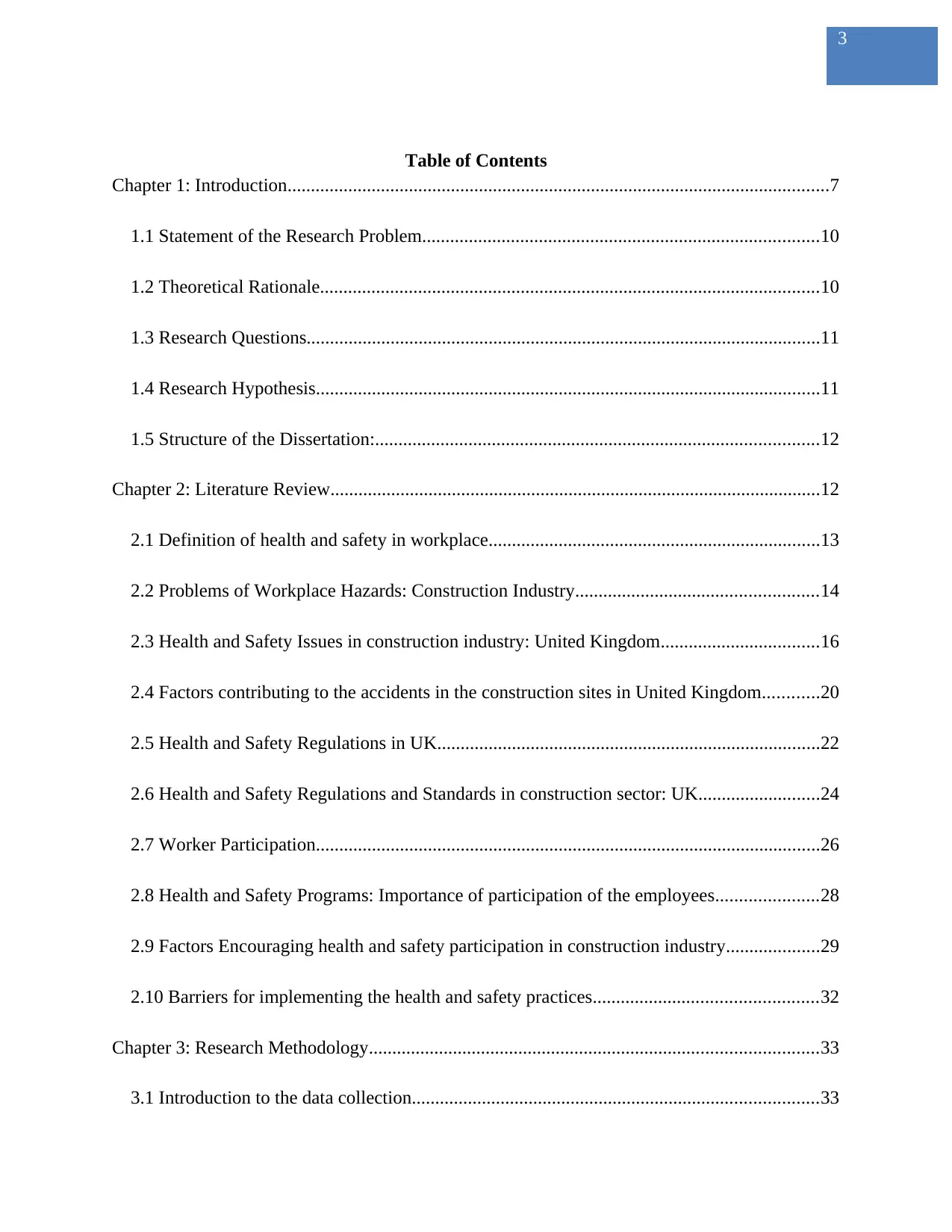
3
Table of Contents
Chapter 1: Introduction....................................................................................................................7
1.1 Statement of the Research Problem.....................................................................................10
1.2 Theoretical Rationale...........................................................................................................10
1.3 Research Questions..............................................................................................................11
1.4 Research Hypothesis............................................................................................................11
1.5 Structure of the Dissertation:...............................................................................................12
Chapter 2: Literature Review.........................................................................................................12
2.1 Definition of health and safety in workplace.......................................................................13
2.2 Problems of Workplace Hazards: Construction Industry....................................................14
2.3 Health and Safety Issues in construction industry: United Kingdom..................................16
2.4 Factors contributing to the accidents in the construction sites in United Kingdom............20
2.5 Health and Safety Regulations in UK..................................................................................22
2.6 Health and Safety Regulations and Standards in construction sector: UK..........................24
2.7 Worker Participation............................................................................................................26
2.8 Health and Safety Programs: Importance of participation of the employees......................28
2.9 Factors Encouraging health and safety participation in construction industry....................29
2.10 Barriers for implementing the health and safety practices................................................32
Chapter 3: Research Methodology................................................................................................33
3.1 Introduction to the data collection.......................................................................................33
Table of Contents
Chapter 1: Introduction....................................................................................................................7
1.1 Statement of the Research Problem.....................................................................................10
1.2 Theoretical Rationale...........................................................................................................10
1.3 Research Questions..............................................................................................................11
1.4 Research Hypothesis............................................................................................................11
1.5 Structure of the Dissertation:...............................................................................................12
Chapter 2: Literature Review.........................................................................................................12
2.1 Definition of health and safety in workplace.......................................................................13
2.2 Problems of Workplace Hazards: Construction Industry....................................................14
2.3 Health and Safety Issues in construction industry: United Kingdom..................................16
2.4 Factors contributing to the accidents in the construction sites in United Kingdom............20
2.5 Health and Safety Regulations in UK..................................................................................22
2.6 Health and Safety Regulations and Standards in construction sector: UK..........................24
2.7 Worker Participation............................................................................................................26
2.8 Health and Safety Programs: Importance of participation of the employees......................28
2.9 Factors Encouraging health and safety participation in construction industry....................29
2.10 Barriers for implementing the health and safety practices................................................32
Chapter 3: Research Methodology................................................................................................33
3.1 Introduction to the data collection.......................................................................................33
⊘ This is a preview!⊘
Do you want full access?
Subscribe today to unlock all pages.

Trusted by 1+ million students worldwide
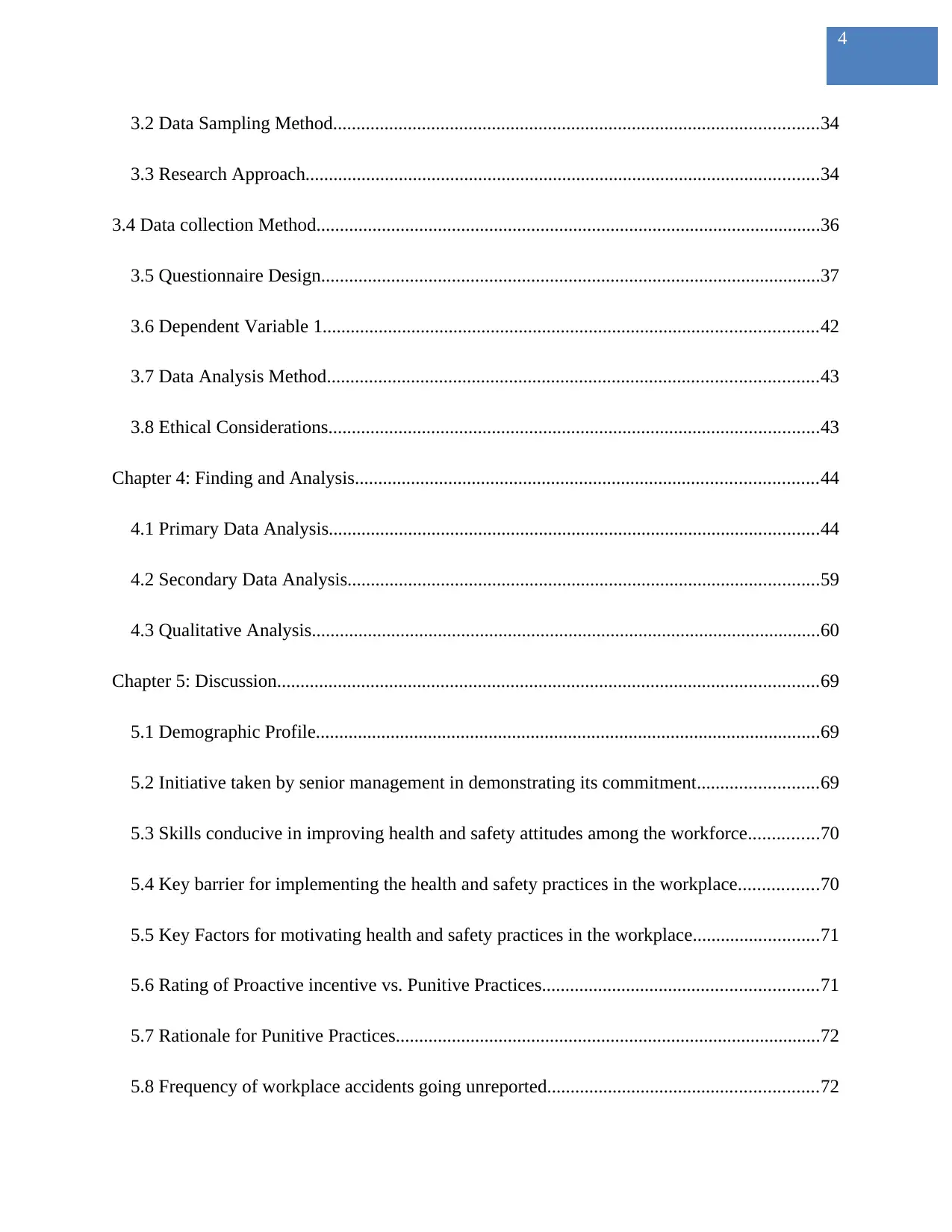
4
3.2 Data Sampling Method........................................................................................................34
3.3 Research Approach..............................................................................................................34
3.4 Data collection Method............................................................................................................36
3.5 Questionnaire Design...........................................................................................................37
3.6 Dependent Variable 1..........................................................................................................42
3.7 Data Analysis Method.........................................................................................................43
3.8 Ethical Considerations.........................................................................................................43
Chapter 4: Finding and Analysis...................................................................................................44
4.1 Primary Data Analysis.........................................................................................................44
4.2 Secondary Data Analysis.....................................................................................................59
4.3 Qualitative Analysis.............................................................................................................60
Chapter 5: Discussion....................................................................................................................69
5.1 Demographic Profile............................................................................................................69
5.2 Initiative taken by senior management in demonstrating its commitment..........................69
5.3 Skills conducive in improving health and safety attitudes among the workforce...............70
5.4 Key barrier for implementing the health and safety practices in the workplace.................70
5.5 Key Factors for motivating health and safety practices in the workplace...........................71
5.6 Rating of Proactive incentive vs. Punitive Practices...........................................................71
5.7 Rationale for Punitive Practices...........................................................................................72
5.8 Frequency of workplace accidents going unreported..........................................................72
3.2 Data Sampling Method........................................................................................................34
3.3 Research Approach..............................................................................................................34
3.4 Data collection Method............................................................................................................36
3.5 Questionnaire Design...........................................................................................................37
3.6 Dependent Variable 1..........................................................................................................42
3.7 Data Analysis Method.........................................................................................................43
3.8 Ethical Considerations.........................................................................................................43
Chapter 4: Finding and Analysis...................................................................................................44
4.1 Primary Data Analysis.........................................................................................................44
4.2 Secondary Data Analysis.....................................................................................................59
4.3 Qualitative Analysis.............................................................................................................60
Chapter 5: Discussion....................................................................................................................69
5.1 Demographic Profile............................................................................................................69
5.2 Initiative taken by senior management in demonstrating its commitment..........................69
5.3 Skills conducive in improving health and safety attitudes among the workforce...............70
5.4 Key barrier for implementing the health and safety practices in the workplace.................70
5.5 Key Factors for motivating health and safety practices in the workplace...........................71
5.6 Rating of Proactive incentive vs. Punitive Practices...........................................................71
5.7 Rationale for Punitive Practices...........................................................................................72
5.8 Frequency of workplace accidents going unreported..........................................................72
Paraphrase This Document
Need a fresh take? Get an instant paraphrase of this document with our AI Paraphraser
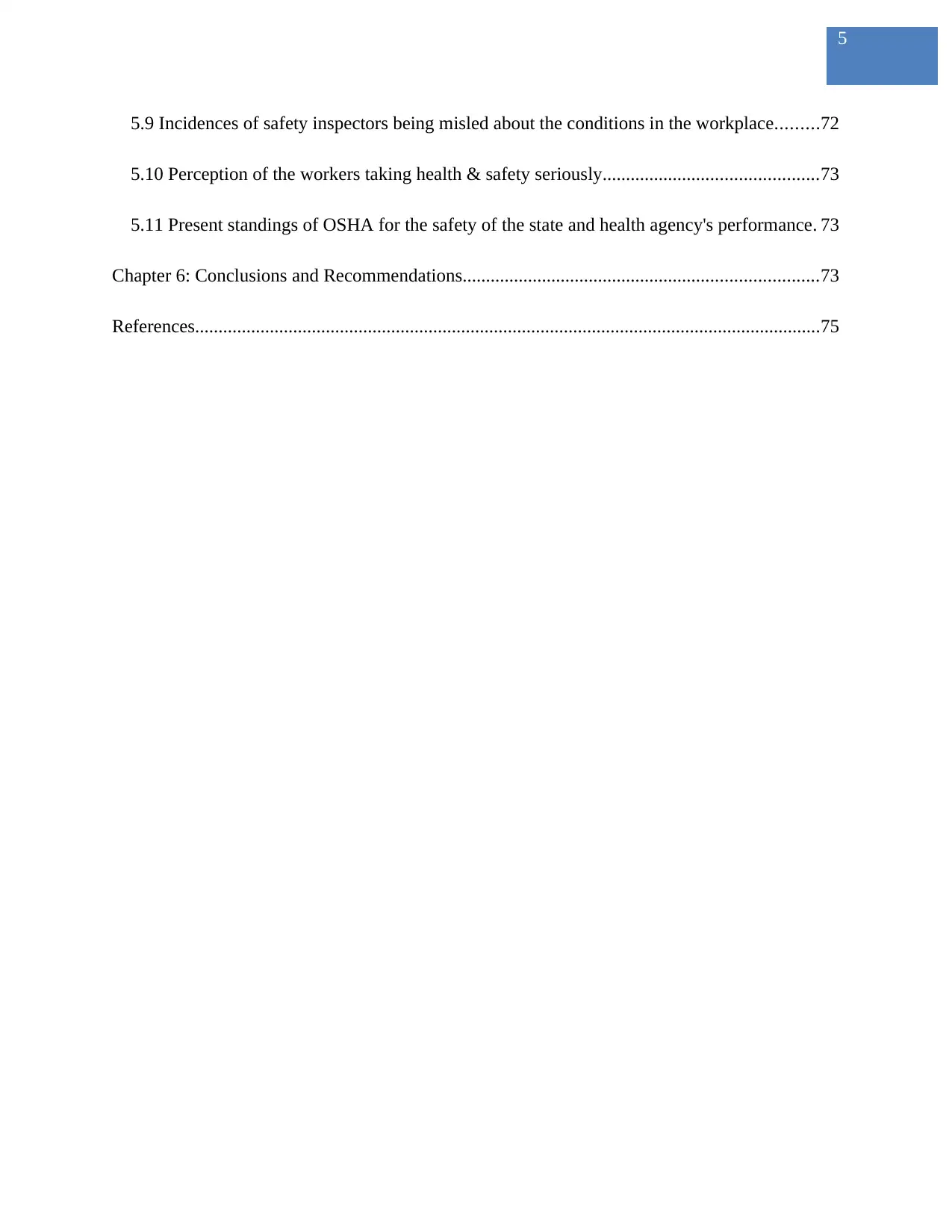
5
5.9 Incidences of safety inspectors being misled about the conditions in the workplace.........72
5.10 Perception of the workers taking health & safety seriously..............................................73
5.11 Present standings of OSHA for the safety of the state and health agency's performance. 73
Chapter 6: Conclusions and Recommendations............................................................................73
References......................................................................................................................................75
5.9 Incidences of safety inspectors being misled about the conditions in the workplace.........72
5.10 Perception of the workers taking health & safety seriously..............................................73
5.11 Present standings of OSHA for the safety of the state and health agency's performance. 73
Chapter 6: Conclusions and Recommendations............................................................................73
References......................................................................................................................................75
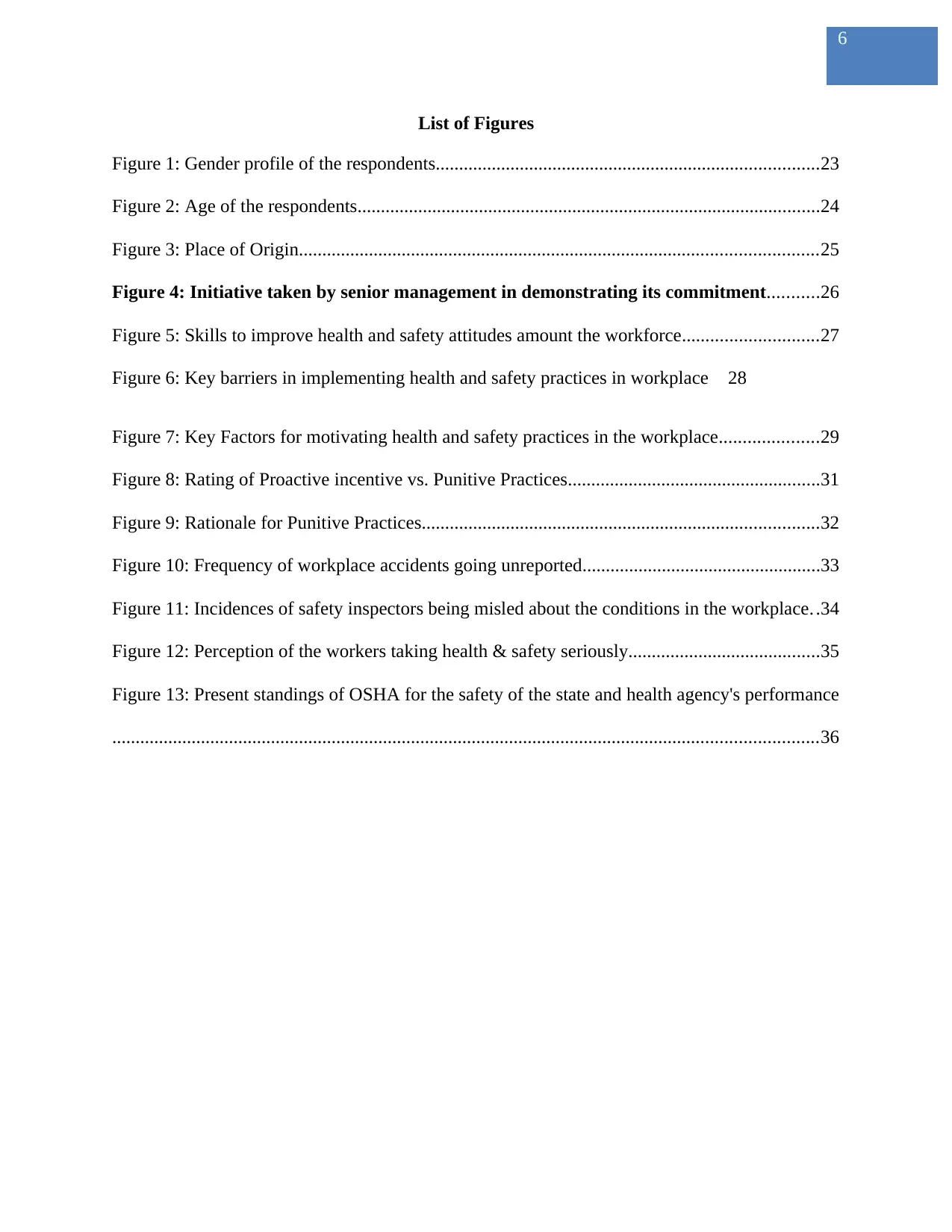
6
List of Figures
Figure 1: Gender profile of the respondents..................................................................................23
Figure 2: Age of the respondents...................................................................................................24
Figure 3: Place of Origin...............................................................................................................25
Figure 4: Initiative taken by senior management in demonstrating its commitment...........26
Figure 5: Skills to improve health and safety attitudes amount the workforce.............................27
Figure 6: Key barriers in implementing health and safety practices in workplace 28
Figure 7: Key Factors for motivating health and safety practices in the workplace.....................29
Figure 8: Rating of Proactive incentive vs. Punitive Practices......................................................31
Figure 9: Rationale for Punitive Practices.....................................................................................32
Figure 10: Frequency of workplace accidents going unreported...................................................33
Figure 11: Incidences of safety inspectors being misled about the conditions in the workplace. .34
Figure 12: Perception of the workers taking health & safety seriously.........................................35
Figure 13: Present standings of OSHA for the safety of the state and health agency's performance
.......................................................................................................................................................36
List of Figures
Figure 1: Gender profile of the respondents..................................................................................23
Figure 2: Age of the respondents...................................................................................................24
Figure 3: Place of Origin...............................................................................................................25
Figure 4: Initiative taken by senior management in demonstrating its commitment...........26
Figure 5: Skills to improve health and safety attitudes amount the workforce.............................27
Figure 6: Key barriers in implementing health and safety practices in workplace 28
Figure 7: Key Factors for motivating health and safety practices in the workplace.....................29
Figure 8: Rating of Proactive incentive vs. Punitive Practices......................................................31
Figure 9: Rationale for Punitive Practices.....................................................................................32
Figure 10: Frequency of workplace accidents going unreported...................................................33
Figure 11: Incidences of safety inspectors being misled about the conditions in the workplace. .34
Figure 12: Perception of the workers taking health & safety seriously.........................................35
Figure 13: Present standings of OSHA for the safety of the state and health agency's performance
.......................................................................................................................................................36
⊘ This is a preview!⊘
Do you want full access?
Subscribe today to unlock all pages.

Trusted by 1+ million students worldwide
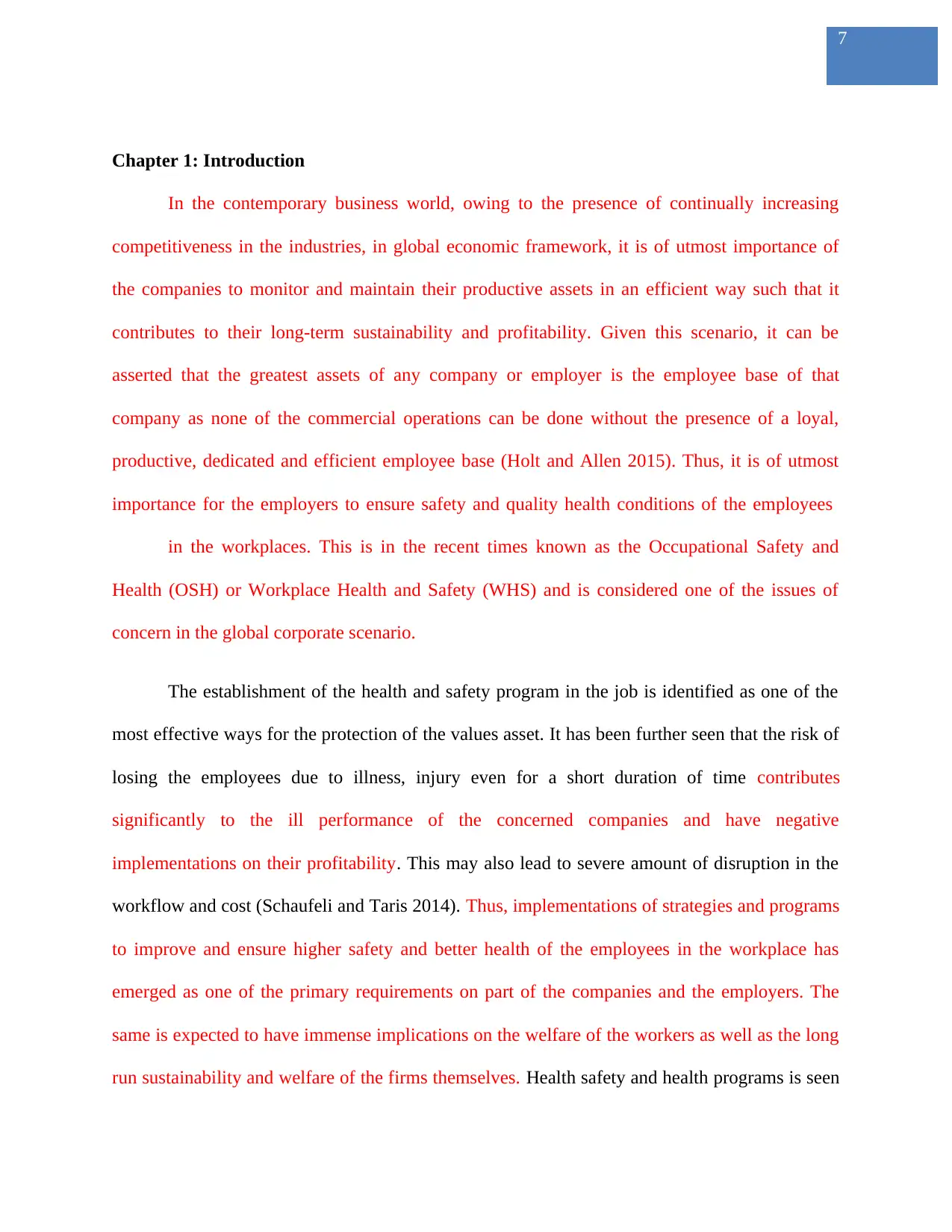
7
Chapter 1: Introduction
In the contemporary business world, owing to the presence of continually increasing
competitiveness in the industries, in global economic framework, it is of utmost importance of
the companies to monitor and maintain their productive assets in an efficient way such that it
contributes to their long-term sustainability and profitability. Given this scenario, it can be
asserted that the greatest assets of any company or employer is the employee base of that
company as none of the commercial operations can be done without the presence of a loyal,
productive, dedicated and efficient employee base (Holt and Allen 2015). Thus, it is of utmost
importance for the employers to ensure safety and quality health conditions of the employees
in the workplaces. This is in the recent times known as the Occupational Safety and
Health (OSH) or Workplace Health and Safety (WHS) and is considered one of the issues of
concern in the global corporate scenario.
The establishment of the health and safety program in the job is identified as one of the
most effective ways for the protection of the values asset. It has been further seen that the risk of
losing the employees due to illness, injury even for a short duration of time contributes
significantly to the ill performance of the concerned companies and have negative
implementations on their profitability. This may also lead to severe amount of disruption in the
workflow and cost (Schaufeli and Taris 2014). Thus, implementations of strategies and programs
to improve and ensure higher safety and better health of the employees in the workplace has
emerged as one of the primary requirements on part of the companies and the employers. The
same is expected to have immense implications on the welfare of the workers as well as the long
run sustainability and welfare of the firms themselves. Health safety and health programs is seen
Chapter 1: Introduction
In the contemporary business world, owing to the presence of continually increasing
competitiveness in the industries, in global economic framework, it is of utmost importance of
the companies to monitor and maintain their productive assets in an efficient way such that it
contributes to their long-term sustainability and profitability. Given this scenario, it can be
asserted that the greatest assets of any company or employer is the employee base of that
company as none of the commercial operations can be done without the presence of a loyal,
productive, dedicated and efficient employee base (Holt and Allen 2015). Thus, it is of utmost
importance for the employers to ensure safety and quality health conditions of the employees
in the workplaces. This is in the recent times known as the Occupational Safety and
Health (OSH) or Workplace Health and Safety (WHS) and is considered one of the issues of
concern in the global corporate scenario.
The establishment of the health and safety program in the job is identified as one of the
most effective ways for the protection of the values asset. It has been further seen that the risk of
losing the employees due to illness, injury even for a short duration of time contributes
significantly to the ill performance of the concerned companies and have negative
implementations on their profitability. This may also lead to severe amount of disruption in the
workflow and cost (Schaufeli and Taris 2014). Thus, implementations of strategies and programs
to improve and ensure higher safety and better health of the employees in the workplace has
emerged as one of the primary requirements on part of the companies and the employers. The
same is expected to have immense implications on the welfare of the workers as well as the long
run sustainability and welfare of the firms themselves. Health safety and health programs is seen
Paraphrase This Document
Need a fresh take? Get an instant paraphrase of this document with our AI Paraphraser
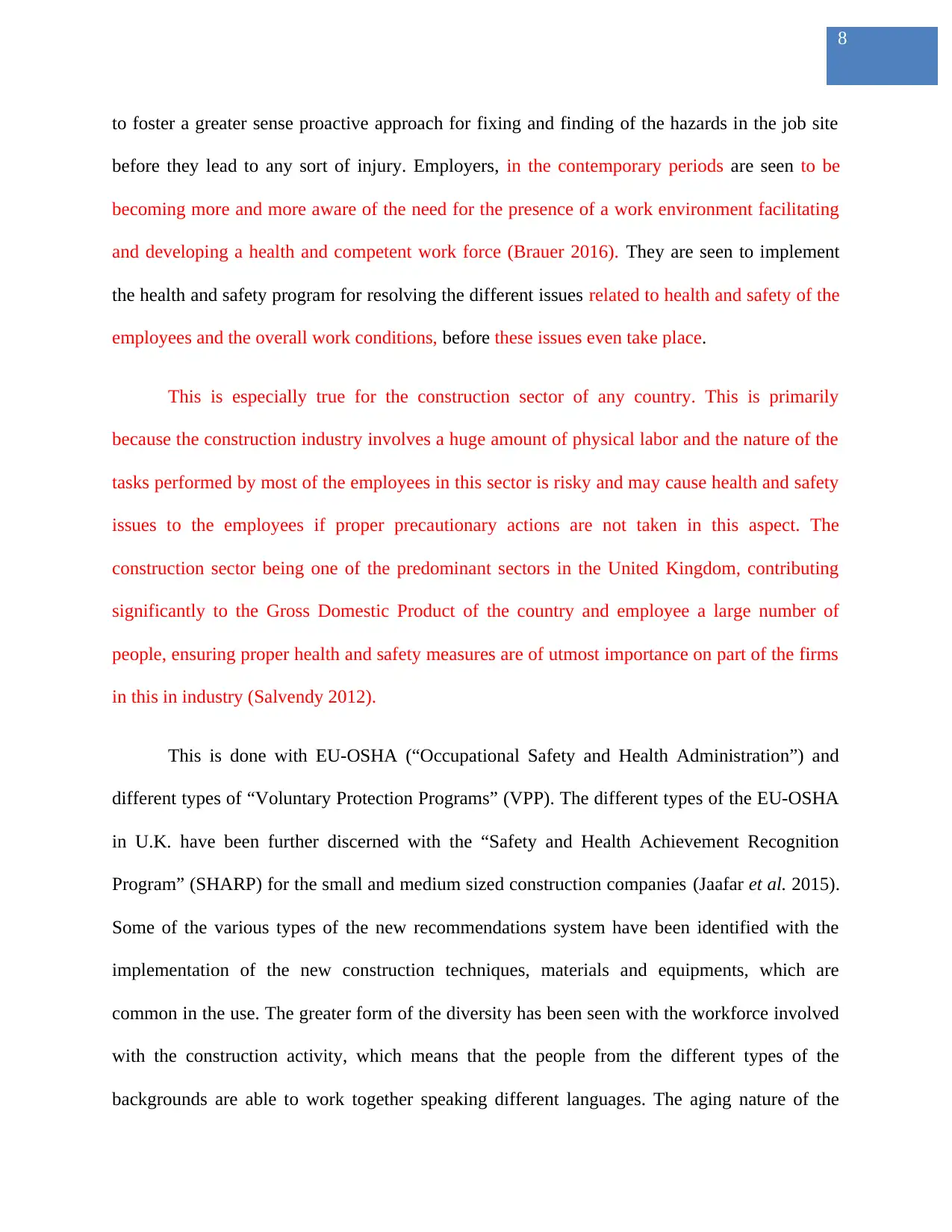
8
to foster a greater sense proactive approach for fixing and finding of the hazards in the job site
before they lead to any sort of injury. Employers, in the contemporary periods are seen to be
becoming more and more aware of the need for the presence of a work environment facilitating
and developing a health and competent work force (Brauer 2016). They are seen to implement
the health and safety program for resolving the different issues related to health and safety of the
employees and the overall work conditions, before these issues even take place.
This is especially true for the construction sector of any country. This is primarily
because the construction industry involves a huge amount of physical labor and the nature of the
tasks performed by most of the employees in this sector is risky and may cause health and safety
issues to the employees if proper precautionary actions are not taken in this aspect. The
construction sector being one of the predominant sectors in the United Kingdom, contributing
significantly to the Gross Domestic Product of the country and employee a large number of
people, ensuring proper health and safety measures are of utmost importance on part of the firms
in this in industry (Salvendy 2012).
This is done with EU-OSHA (“Occupational Safety and Health Administration”) and
different types of “Voluntary Protection Programs” (VPP). The different types of the EU-OSHA
in U.K. have been further discerned with the “Safety and Health Achievement Recognition
Program” (SHARP) for the small and medium sized construction companies (Jaafar et al. 2015).
Some of the various types of the new recommendations system have been identified with the
implementation of the new construction techniques, materials and equipments, which are
common in the use. The greater form of the diversity has been seen with the workforce involved
with the construction activity, which means that the people from the different types of the
backgrounds are able to work together speaking different languages. The aging nature of the
to foster a greater sense proactive approach for fixing and finding of the hazards in the job site
before they lead to any sort of injury. Employers, in the contemporary periods are seen to be
becoming more and more aware of the need for the presence of a work environment facilitating
and developing a health and competent work force (Brauer 2016). They are seen to implement
the health and safety program for resolving the different issues related to health and safety of the
employees and the overall work conditions, before these issues even take place.
This is especially true for the construction sector of any country. This is primarily
because the construction industry involves a huge amount of physical labor and the nature of the
tasks performed by most of the employees in this sector is risky and may cause health and safety
issues to the employees if proper precautionary actions are not taken in this aspect. The
construction sector being one of the predominant sectors in the United Kingdom, contributing
significantly to the Gross Domestic Product of the country and employee a large number of
people, ensuring proper health and safety measures are of utmost importance on part of the firms
in this in industry (Salvendy 2012).
This is done with EU-OSHA (“Occupational Safety and Health Administration”) and
different types of “Voluntary Protection Programs” (VPP). The different types of the EU-OSHA
in U.K. have been further discerned with the “Safety and Health Achievement Recognition
Program” (SHARP) for the small and medium sized construction companies (Jaafar et al. 2015).
Some of the various types of the new recommendations system have been identified with the
implementation of the new construction techniques, materials and equipments, which are
common in the use. The greater form of the diversity has been seen with the workforce involved
with the construction activity, which means that the people from the different types of the
backgrounds are able to work together speaking different languages. The aging nature of the
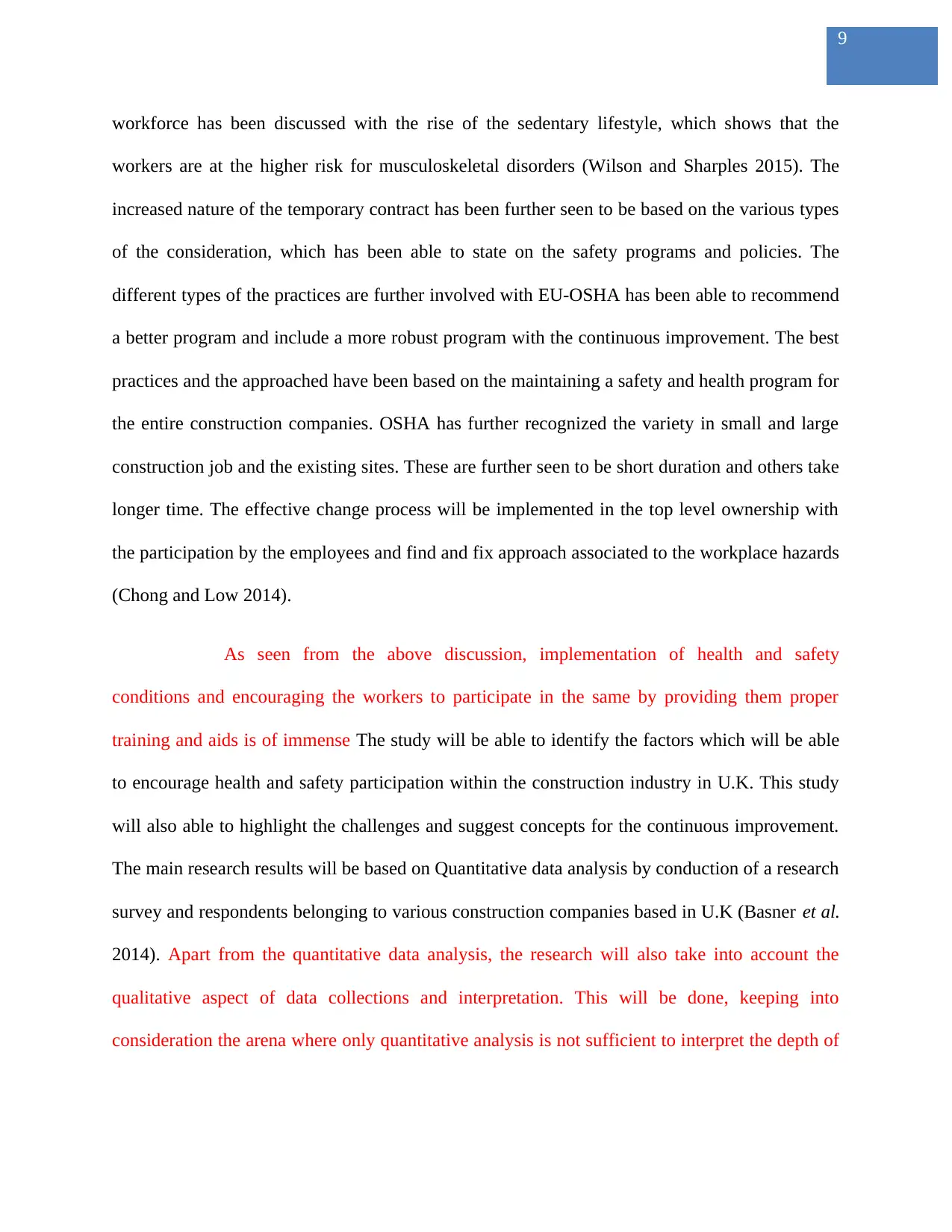
9
workforce has been discussed with the rise of the sedentary lifestyle, which shows that the
workers are at the higher risk for musculoskeletal disorders (Wilson and Sharples 2015). The
increased nature of the temporary contract has been further seen to be based on the various types
of the consideration, which has been able to state on the safety programs and policies. The
different types of the practices are further involved with EU-OSHA has been able to recommend
a better program and include a more robust program with the continuous improvement. The best
practices and the approached have been based on the maintaining a safety and health program for
the entire construction companies. OSHA has further recognized the variety in small and large
construction job and the existing sites. These are further seen to be short duration and others take
longer time. The effective change process will be implemented in the top level ownership with
the participation by the employees and find and fix approach associated to the workplace hazards
(Chong and Low 2014).
As seen from the above discussion, implementation of health and safety
conditions and encouraging the workers to participate in the same by providing them proper
training and aids is of immense The study will be able to identify the factors which will be able
to encourage health and safety participation within the construction industry in U.K. This study
will also able to highlight the challenges and suggest concepts for the continuous improvement.
The main research results will be based on Quantitative data analysis by conduction of a research
survey and respondents belonging to various construction companies based in U.K (Basner et al.
2014). Apart from the quantitative data analysis, the research will also take into account the
qualitative aspect of data collections and interpretation. This will be done, keeping into
consideration the arena where only quantitative analysis is not sufficient to interpret the depth of
workforce has been discussed with the rise of the sedentary lifestyle, which shows that the
workers are at the higher risk for musculoskeletal disorders (Wilson and Sharples 2015). The
increased nature of the temporary contract has been further seen to be based on the various types
of the consideration, which has been able to state on the safety programs and policies. The
different types of the practices are further involved with EU-OSHA has been able to recommend
a better program and include a more robust program with the continuous improvement. The best
practices and the approached have been based on the maintaining a safety and health program for
the entire construction companies. OSHA has further recognized the variety in small and large
construction job and the existing sites. These are further seen to be short duration and others take
longer time. The effective change process will be implemented in the top level ownership with
the participation by the employees and find and fix approach associated to the workplace hazards
(Chong and Low 2014).
As seen from the above discussion, implementation of health and safety
conditions and encouraging the workers to participate in the same by providing them proper
training and aids is of immense The study will be able to identify the factors which will be able
to encourage health and safety participation within the construction industry in U.K. This study
will also able to highlight the challenges and suggest concepts for the continuous improvement.
The main research results will be based on Quantitative data analysis by conduction of a research
survey and respondents belonging to various construction companies based in U.K (Basner et al.
2014). Apart from the quantitative data analysis, the research will also take into account the
qualitative aspect of data collections and interpretation. This will be done, keeping into
consideration the arena where only quantitative analysis is not sufficient to interpret the depth of
⊘ This is a preview!⊘
Do you want full access?
Subscribe today to unlock all pages.

Trusted by 1+ million students worldwide
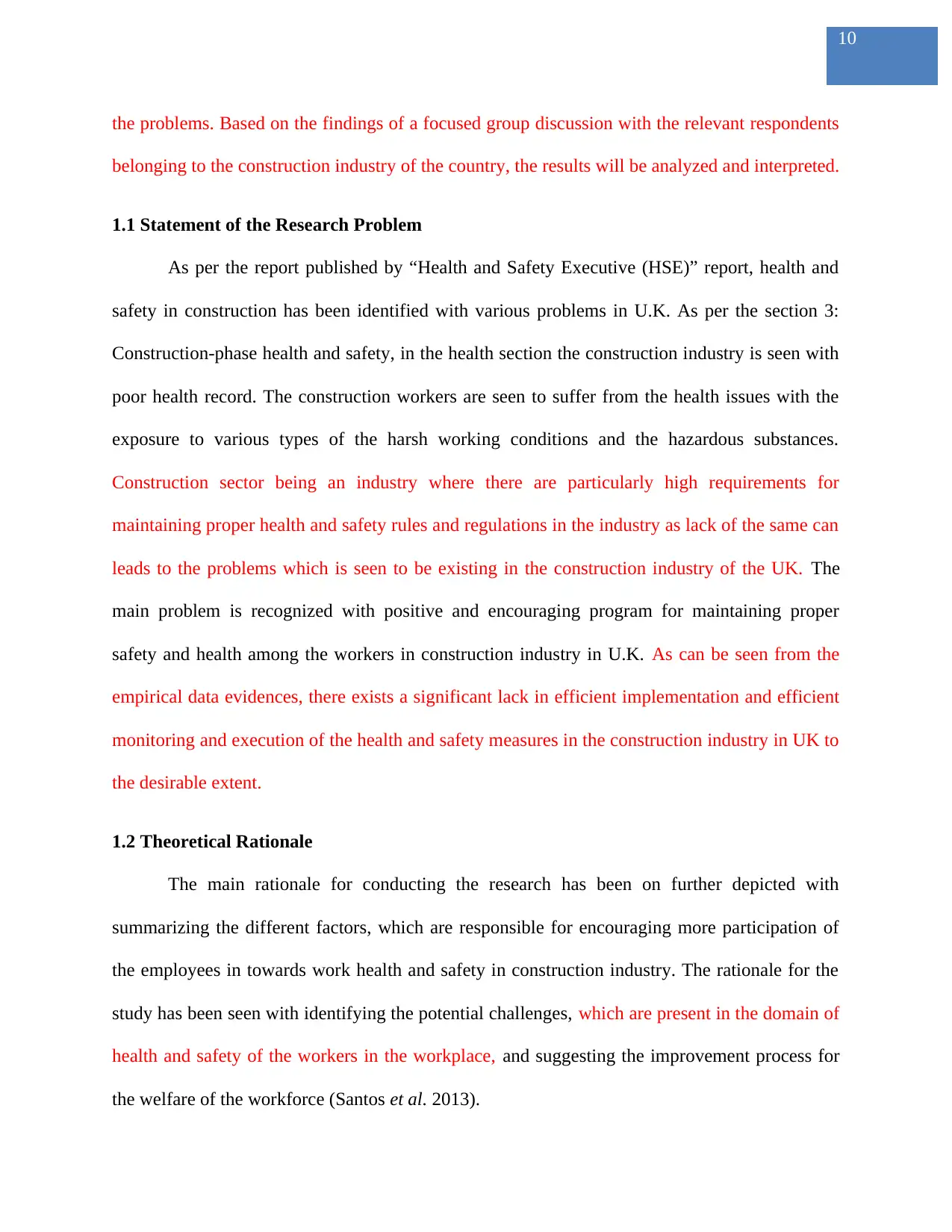
10
the problems. Based on the findings of a focused group discussion with the relevant respondents
belonging to the construction industry of the country, the results will be analyzed and interpreted.
1.1 Statement of the Research Problem
As per the report published by “Health and Safety Executive (HSE)” report, health and
safety in construction has been identified with various problems in U.K. As per the section 3:
Construction-phase health and safety, in the health section the construction industry is seen with
poor health record. The construction workers are seen to suffer from the health issues with the
exposure to various types of the harsh working conditions and the hazardous substances.
Construction sector being an industry where there are particularly high requirements for
maintaining proper health and safety rules and regulations in the industry as lack of the same can
leads to the problems which is seen to be existing in the construction industry of the UK. The
main problem is recognized with positive and encouraging program for maintaining proper
safety and health among the workers in construction industry in U.K. As can be seen from the
empirical data evidences, there exists a significant lack in efficient implementation and efficient
monitoring and execution of the health and safety measures in the construction industry in UK to
the desirable extent.
1.2 Theoretical Rationale
The main rationale for conducting the research has been on further depicted with
summarizing the different factors, which are responsible for encouraging more participation of
the employees in towards work health and safety in construction industry. The rationale for the
study has been seen with identifying the potential challenges, which are present in the domain of
health and safety of the workers in the workplace, and suggesting the improvement process for
the welfare of the workforce (Santos et al. 2013).
the problems. Based on the findings of a focused group discussion with the relevant respondents
belonging to the construction industry of the country, the results will be analyzed and interpreted.
1.1 Statement of the Research Problem
As per the report published by “Health and Safety Executive (HSE)” report, health and
safety in construction has been identified with various problems in U.K. As per the section 3:
Construction-phase health and safety, in the health section the construction industry is seen with
poor health record. The construction workers are seen to suffer from the health issues with the
exposure to various types of the harsh working conditions and the hazardous substances.
Construction sector being an industry where there are particularly high requirements for
maintaining proper health and safety rules and regulations in the industry as lack of the same can
leads to the problems which is seen to be existing in the construction industry of the UK. The
main problem is recognized with positive and encouraging program for maintaining proper
safety and health among the workers in construction industry in U.K. As can be seen from the
empirical data evidences, there exists a significant lack in efficient implementation and efficient
monitoring and execution of the health and safety measures in the construction industry in UK to
the desirable extent.
1.2 Theoretical Rationale
The main rationale for conducting the research has been on further depicted with
summarizing the different factors, which are responsible for encouraging more participation of
the employees in towards work health and safety in construction industry. The rationale for the
study has been seen with identifying the potential challenges, which are present in the domain of
health and safety of the workers in the workplace, and suggesting the improvement process for
the welfare of the workforce (Santos et al. 2013).
Paraphrase This Document
Need a fresh take? Get an instant paraphrase of this document with our AI Paraphraser
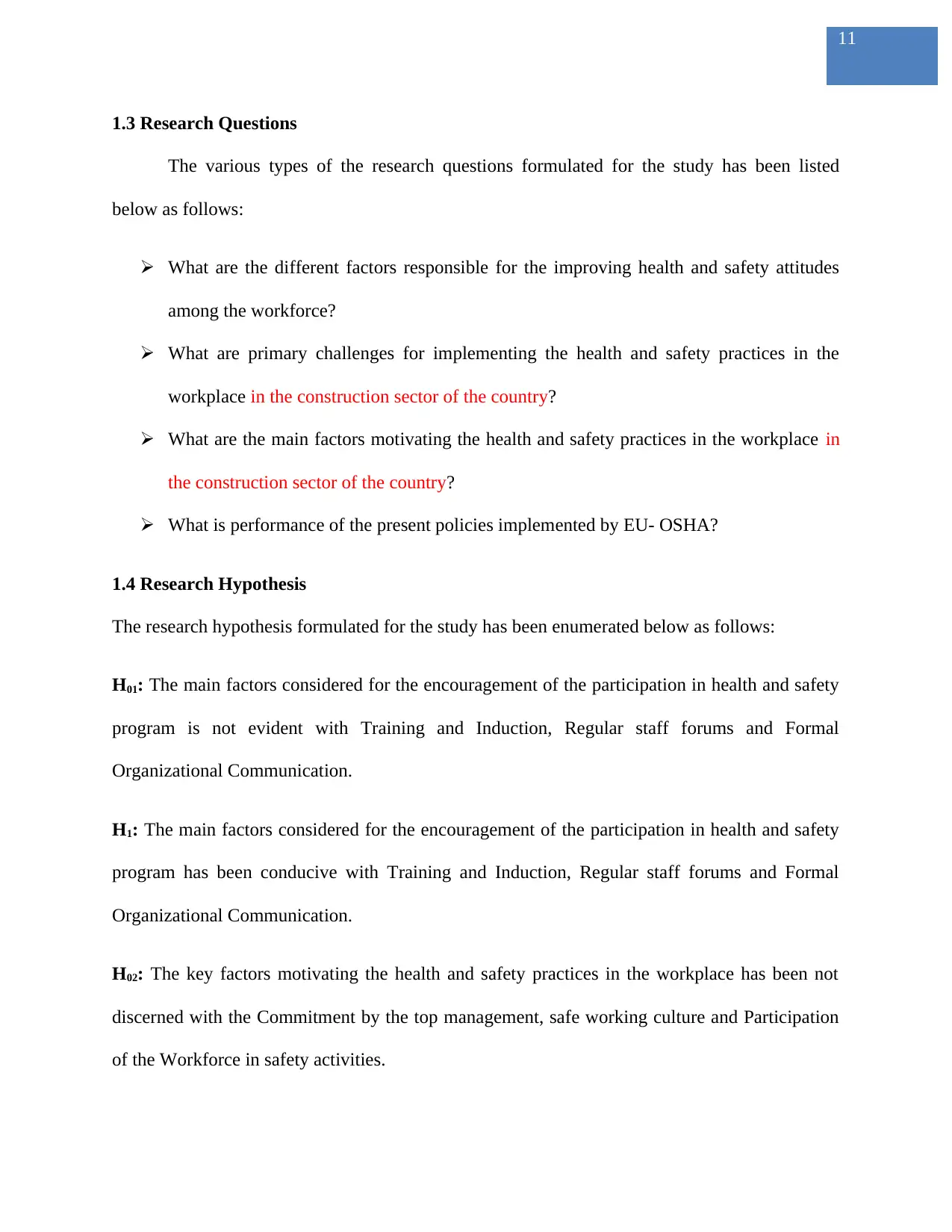
11
1.3 Research Questions
The various types of the research questions formulated for the study has been listed
below as follows:
What are the different factors responsible for the improving health and safety attitudes
among the workforce?
What are primary challenges for implementing the health and safety practices in the
workplace in the construction sector of the country?
What are the main factors motivating the health and safety practices in the workplace in
the construction sector of the country?
What is performance of the present policies implemented by EU- OSHA?
1.4 Research Hypothesis
The research hypothesis formulated for the study has been enumerated below as follows:
H01: The main factors considered for the encouragement of the participation in health and safety
program is not evident with Training and Induction, Regular staff forums and Formal
Organizational Communication.
H1: The main factors considered for the encouragement of the participation in health and safety
program has been conducive with Training and Induction, Regular staff forums and Formal
Organizational Communication.
H02: The key factors motivating the health and safety practices in the workplace has been not
discerned with the Commitment by the top management, safe working culture and Participation
of the Workforce in safety activities.
1.3 Research Questions
The various types of the research questions formulated for the study has been listed
below as follows:
What are the different factors responsible for the improving health and safety attitudes
among the workforce?
What are primary challenges for implementing the health and safety practices in the
workplace in the construction sector of the country?
What are the main factors motivating the health and safety practices in the workplace in
the construction sector of the country?
What is performance of the present policies implemented by EU- OSHA?
1.4 Research Hypothesis
The research hypothesis formulated for the study has been enumerated below as follows:
H01: The main factors considered for the encouragement of the participation in health and safety
program is not evident with Training and Induction, Regular staff forums and Formal
Organizational Communication.
H1: The main factors considered for the encouragement of the participation in health and safety
program has been conducive with Training and Induction, Regular staff forums and Formal
Organizational Communication.
H02: The key factors motivating the health and safety practices in the workplace has been not
discerned with the Commitment by the top management, safe working culture and Participation
of the Workforce in safety activities.
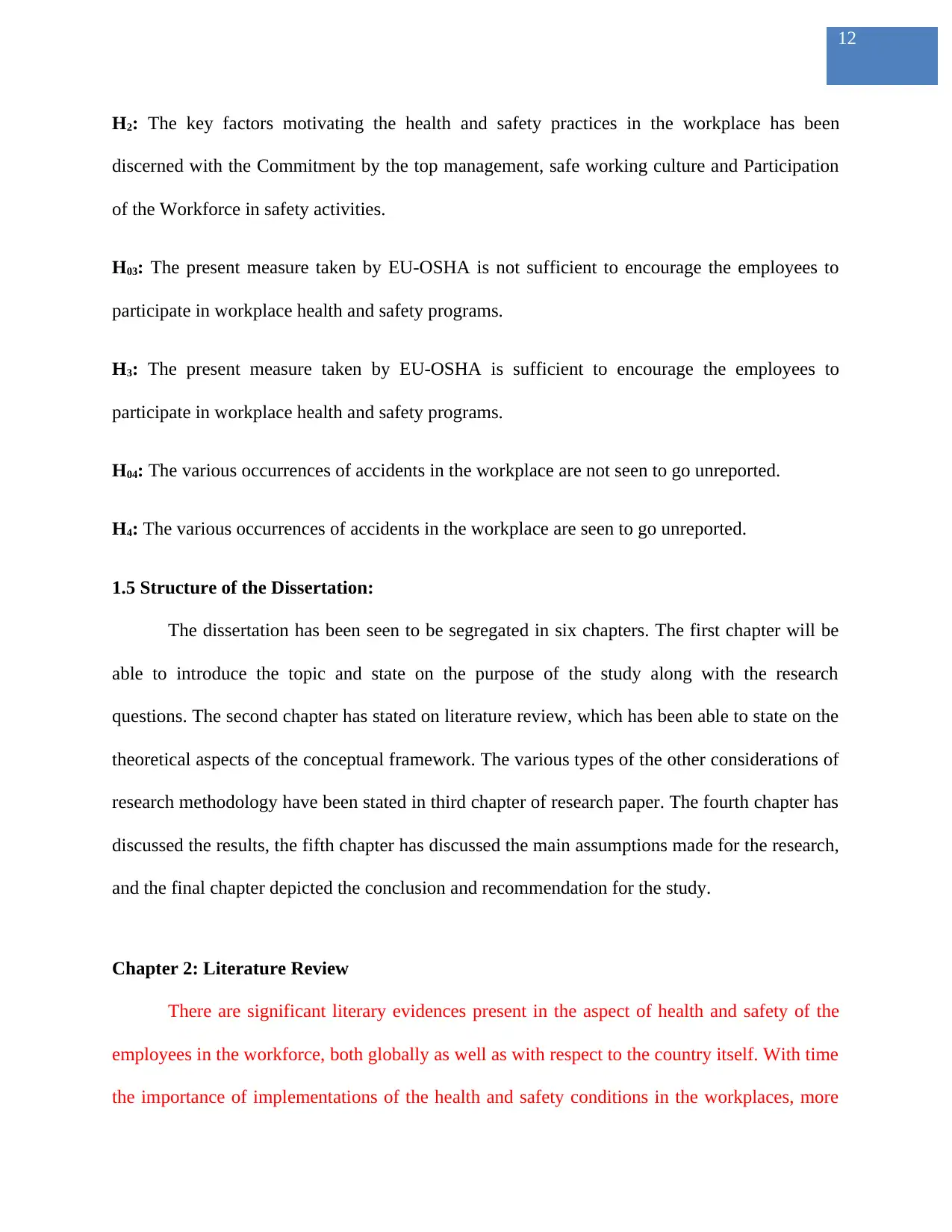
12
H2: The key factors motivating the health and safety practices in the workplace has been
discerned with the Commitment by the top management, safe working culture and Participation
of the Workforce in safety activities.
H03: The present measure taken by EU-OSHA is not sufficient to encourage the employees to
participate in workplace health and safety programs.
H3: The present measure taken by EU-OSHA is sufficient to encourage the employees to
participate in workplace health and safety programs.
H04: The various occurrences of accidents in the workplace are not seen to go unreported.
H4: The various occurrences of accidents in the workplace are seen to go unreported.
1.5 Structure of the Dissertation:
The dissertation has been seen to be segregated in six chapters. The first chapter will be
able to introduce the topic and state on the purpose of the study along with the research
questions. The second chapter has stated on literature review, which has been able to state on the
theoretical aspects of the conceptual framework. The various types of the other considerations of
research methodology have been stated in third chapter of research paper. The fourth chapter has
discussed the results, the fifth chapter has discussed the main assumptions made for the research,
and the final chapter depicted the conclusion and recommendation for the study.
Chapter 2: Literature Review
There are significant literary evidences present in the aspect of health and safety of the
employees in the workforce, both globally as well as with respect to the country itself. With time
the importance of implementations of the health and safety conditions in the workplaces, more
H2: The key factors motivating the health and safety practices in the workplace has been
discerned with the Commitment by the top management, safe working culture and Participation
of the Workforce in safety activities.
H03: The present measure taken by EU-OSHA is not sufficient to encourage the employees to
participate in workplace health and safety programs.
H3: The present measure taken by EU-OSHA is sufficient to encourage the employees to
participate in workplace health and safety programs.
H04: The various occurrences of accidents in the workplace are not seen to go unreported.
H4: The various occurrences of accidents in the workplace are seen to go unreported.
1.5 Structure of the Dissertation:
The dissertation has been seen to be segregated in six chapters. The first chapter will be
able to introduce the topic and state on the purpose of the study along with the research
questions. The second chapter has stated on literature review, which has been able to state on the
theoretical aspects of the conceptual framework. The various types of the other considerations of
research methodology have been stated in third chapter of research paper. The fourth chapter has
discussed the results, the fifth chapter has discussed the main assumptions made for the research,
and the final chapter depicted the conclusion and recommendation for the study.
Chapter 2: Literature Review
There are significant literary evidences present in the aspect of health and safety of the
employees in the workforce, both globally as well as with respect to the country itself. With time
the importance of implementations of the health and safety conditions in the workplaces, more
⊘ This is a preview!⊘
Do you want full access?
Subscribe today to unlock all pages.

Trusted by 1+ million students worldwide
1 out of 83
Related Documents
Your All-in-One AI-Powered Toolkit for Academic Success.
+13062052269
info@desklib.com
Available 24*7 on WhatsApp / Email
![[object Object]](/_next/static/media/star-bottom.7253800d.svg)
Unlock your academic potential
Copyright © 2020–2025 A2Z Services. All Rights Reserved. Developed and managed by ZUCOL.





